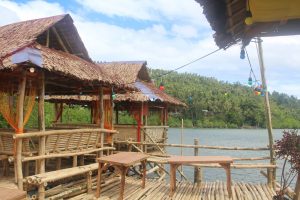
Cabucgayan, Biliran – This summer, visit this destination area which is reclaiming its spot as one of the top tourist attractions in this island province as it reopened to visitors.
Thanks to beneficiaries of Pantawid Pamilyang Pilipino Program of the Department of Social Welfare and Development (DSWD) who helped carry out the rehabilitation of this mangrove area which was famous for its ‘floating’ boardwalk before Super Typhoon Yolanda hit the Visayas Region in 2013. The rehabilitation of the mangrove area is a project by the Local Government Unit (LGU).
The DSWD, through its Field Office (FO) in Region VIII, allotted a total of P838,500 last year for its Cash-for-Building-Livelihood-Assets (CBLA) under its Sustainable Livelihood Program (SLP) to help in the rehabilitation of the mangrove area.
The CBLA program of the Department provides immediate cash assistance to indigent individuals in exchange of providing community-based labor to repair, rehabilitate, or develop physical and natural resources that will be used for productive and profitable microenterprises.
Some 105 Pantawid Pamilya beneficiaries from Sitios Naga, Rawis, and Villa Corro of Barangay Looc were able to avail of the CBLA. The program also provided additional source of income to about 100 more residents of the barangay.
Under the CBLA, the beneficiaries were able to earn P260 per day by providing labor support for the rehabilitation of the mangrove area. The work they provided included planting of mangroves along the shorelines, cultivating of a tree nursery, repairing of the boardwalk, and constructing of a multi-purpose center.
The rehabilitation project started in March 2016 and ended in November of the same year.
The newly-rehabilitated mangrove area features a restaurant and new cottages where tourists can enjoy the picturesque view of the river and the surrounding mangroves.
To date, it is fast becoming a famous eco-tourism destination not just in the town, but in the whole province, which results in the continuous creation of more job opportunities for the locals.
Other than adding beauty to river shorelines and serving as habitat for different species of small fishes and other marine animals, mangroves are a great barrier against storm surge.
According to DSWD Secretary Judy M. Taguiwalo, the Department strives to provide more livelihood projects to its program beneficiaries, specifically those under 4Ps, so they will have additional sources of income and be able to provide for their family.
“We partner with LGUs to provide additional sources of income to our beneficiaries so they will learn to provide for their family using their own efforts,” Sec. Taguiwalo said.
“We also make it a point to include non-Pantawid Pamilya beneficiaries to our livelihood projects as we admit that there are still millions of poor Filipinos not enrolled in the conditional cash transfer who also need assistance. Rest assured that the DSWD is doing its best to improve its programs and services and to make them available to all those who are in need,” Sec. Taguiwalo said.
The Sustainable Livelihood Program (SLP) is a community-based capacity building program that seeks to increase the economic opportunities of Filipinos through the Community-Driven Enterprise Development Approach, which equips people to actively contribute to production and labor markets by looking at available resources and accessible markets. SLP has two tracks, including the micro-enterprise development track and the employment facilitation track.
Pantawid Pamilya is a human development program implemented by the DSWD that invests in the health and education of poor families, primarily those with children aged 0-18. It provides monthly cash grants to beneficiaries who comply with the conditions of sending their children to school, bringing them to health centers, and attending the Family Development Sessions (FDS). ###


